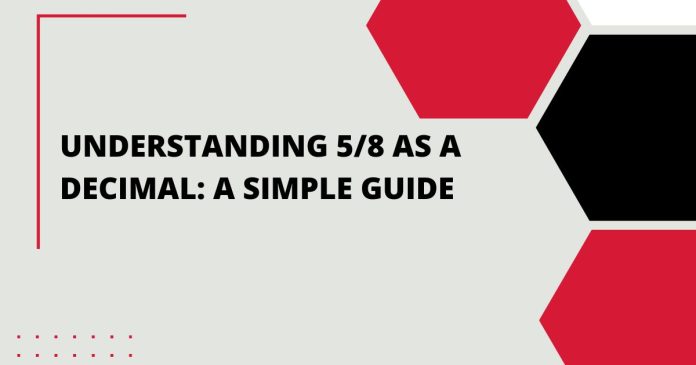Are you struggling to grasp the concept of converting fractions into decimals? Don’t worry; we’ve got you covered! In this article, we’ll delve into the world of fractions and decimals, with a specific focus on how to express 5/8 as a decimal. Whether you’re a student tackling math homework or simply curious about mathematical conversions, we’ll break it down step by step. Let’s jump right in!
Table of Contents
- Introduction
- The Basics: Fractions and Decimals
- Converting Fractions to Decimals: The Method
- 5/8 as a Fraction: Understanding the Components
- Step-by-Step Conversion of 5/8 to a Decimal
- Why Does Decimal Conversion Matter?
- Real-Life Applications
- Embracing the Concept: Practice Problems
- Tricks and Tips for Quick Conversions
- Common Pitfalls to Avoid
- Exploring Other Fraction Conversions
- The Beauty of Mathematics: Finding Patterns
- The Significance of Terminating and Repeating Decimals
- Wrapping Up: Mastering Fraction-to-Decimal Conversion
- Conclusion
Introduction
Fractions and decimals are fundamental concepts in mathematics, often encountered in various real-life situations. The ability to convert fractions to decimals and vice versa is a crucial skill that can come in handy in everyday scenarios, ranging from cooking measurements to construction projects. In this article, we’ll focus on the fraction 5/8 and its representation as a decimal.
The Basics: Fractions and Decimals
Before diving into the conversion process, let’s briefly review what fractions and decimals are. A fraction represents a part of a whole and consists of two components: the numerator (the top number) and the denominator (the bottom number). On the other hand, decimals are a way of expressing numbers in base 10, using a decimal point to separate the whole and fractional parts.
Converting Fractions to Decimals: The Method
The process of converting a fraction to a decimal involves division. To convert any fraction into a decimal, you divide the numerator by the denominator. The result of this division is the decimal equivalent of the fraction.
5/8 as a Fraction: Understanding the Components
In the fraction 5/8, the numerator is 5, and the denominator is 8. The numerator represents the number of parts we have, while the denominator signifies the total number of equal parts into which the whole is divided.
Step-by-Step Conversion of 5/8 to a Decimal
Now, let’s convert 5/8 into a decimal. Follow these steps:
- Divide the numerator (5) by the denominator (8).
- The result is 0.625.
So, 5/8 as a decimal is 0.625.
Why Does Decimal Conversion Matter?
Decimal conversion is a crucial skill because it allows us to easily compare fractions and understand their relative sizes. Decimals provide a standardized way to express parts of a whole, making mathematical calculations and comparisons more manageable.
Real-Life Applications
Understanding decimal conversions is not just confined to textbooks. It has practical applications in various fields, including:
- Cooking: Adjusting recipe quantities based on the number of servings.
- Finance: Calculating interest rates and percentages.
- Construction: Measuring materials and dimensions accurately.
Embracing the Concept: Practice Problems
To solidify your understanding, let’s try a few practice problems:
- Convert 3/4 to a decimal.
- Express 7/20 as a decimal.
- What is 2/5 as a decimal?
Tricks and Tips for Quick Conversions
Here are some handy tricks to simplify fraction-to-decimal conversions:
- Divide and Multiply: If the numerator can be evenly divided by the denominator, the decimal will terminate (no repeating digits).
- Recognize Patterns: Some fractions have repeating decimals (e.g., 1/3 = 0.333…).
Common Pitfalls to Avoid
When dealing with conversions, keep an eye out for:
- Dividing Errors: Miscalculations during division can lead to incorrect decimals.
- Misplaced Decimal Points: Ensure the decimal point is positioned correctly in the final answer.
Exploring Other Fraction Conversions
While we focused on 5/8, the method applies to all fractions. Practice various conversions to build confidence in the process.
The Beauty of Mathematics: Finding Patterns
Mathematics is about patterns and connections. As you delve deeper into fraction and decimal conversions, you’ll notice fascinating relationships between different fractions and their decimal counterparts.
The Significance of Terminating and Repeating Decimals
Decimal conversions can result in two types of decimals: terminating (ending) and repeating (cyclical). Understanding their properties can offer insights into the underlying fraction.
Wrapping Up: Mastering Fraction-to-Decimal Conversion
Converting fractions to decimals is an essential mathematical skill with applications in multiple aspects of life. By mastering this process, you empower yourself to confidently navigate various real-world scenarios that involve fractions and decimals.
Conclusion
In conclusion, the journey from fractions to decimals might seem daunting at first, but with practice and understanding, it becomes a valuable tool in your mathematical toolkit. By converting fractions to decimals, you unlock the ability to work seamlessly with these numerical representations and tackle everyday challenges with confidence.
FAQs
Q1: Is there an easy way to convert any fraction into a decimal? A1: Yes, simply divide the numerator by the denominator to get the decimal equivalent.
Q2: Can fractions with larger denominators be easily converted into decimals? A2: Absolutely. The process remains the same regardless of the denominator’s size.
Q3: What if the division result doesn’t have a pattern and goes on indefinitely? A3: That’s a repeating decimal, which can be represented as a fraction. For instance, 1/3 is 0.333…, where the 3s repeat.
Q4: How can I practice fraction-to-decimal conversions? A4: Use online resources, math practice books, and create your own examples for practice.
Q5: Where can I learn more about other mathematical conversions? A5: You can explore online math tutorials, educational websites, and math-related forums.

